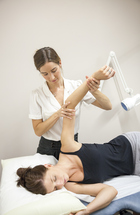Rehabilitation for Lateral Epicondylitis

Lateral epicondylitis, also known as tennis elbow, is an elbow injury caused by overuse of the muscles and tendons of the forearm and elbow. The pain associated with this condition affects the lateral epicondyle, the area where the tendons of the forearm connect with the bony outer portion of the elbow. Repetitive movement and constant use during certain types of activities can put excessive strain on the elbow tendons. Although tennis elbow can occur in tennis players, and those who participate in certain athletic activities, it can also occur in people who have jobs that involve repetitive motions of the wrist and arm, such as carpenters, or people in construction-related trades.
The initial pain caused by tennis elbow is often managed with rest, ice and over-the-counter pain medication. In many cases, tennis elbow heals on its own. Conditions that do not respond to conservative measures may require additional treatment in the form of physical therapy, exercises, orthotics or corticosteroids. Severe, persistent cases of tennis elbow may require surgery.
Nonsurgical Rehabilitation
Patients with mild cases of lateral epicondylitis may benefit from physical therapy to minimize pain and restore movement. Initial physical therapy treatments control pain and promote healing by using ice or electrical stimulation. Massage may also be used to ease muscle pain. A physical therapist will guide the patient in exercises to gradually stretch and strengthen the muscles of the forearm. Recommendations may also be made about how to alleviate stress to the injured muscles, and avoid reinjury. With physical therapy, recovery takes about 3 months, although more severe cases can take up to 6 months.
Postsurgical Rehabilitation
Severe cases of lateral epicondylitis that do not respond to other treatments may require surgery to alleviate pain and restore movement to the elbow. Surgical procedures may be used to remove damaged tissue or bone spurs, or to split the tendons to alleviate pressure. After surgery, the elbow is placed in a splint. Initial physical therapy treatments include ice, electrical stimulation and massage, which help with pain, swelling and muscle spasms. About 2 or 3 weeks after surgery, a physical therapist prescribes exercises that work and stretch the muscles of the forearm, without straining healing tissue. Additional physical therapy treatments include the following:
- Muscle-strengthening exercises
- Range-of-motion exercises
- Exercises for fine motor skills
- Hand-dexterity exercises
Physical therapy treatments focus on helping the patient return to all usual activities. If surgery is performed, physical therapy may be necessary for up to 4 months, and full recovery may take up to 6 months.

